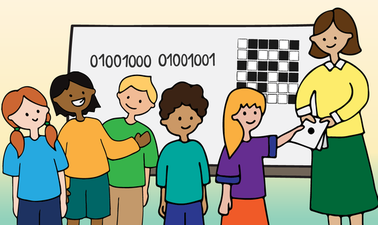- Level Foundation
- المدة 15 hours
- الطبع بواسطة University of Canterbury
- Total students 803 enrolled
-
Offered by

عن
This course is designed to show you how to teach computational thinking to children aged 7-12+. The course will be valuable to you, whether you are new to this approach or an enthusiastic practitioner. It offers ways to explore computational thinking using simple tools readily available in classrooms and homes, such as cards, chalk and scales to engage with students.
Based on the content in the popular open-source CS Unplugged website (csunplugged.org), this course demonstrates how to teach computational thinking from unplugged to plugging-it-in with programming.
Each module will weave in the following:
- Connections to apply CS Unplugged into classroom programmes by structuring the modules to have suitable activities that lead on from each other.
- An explanation of why we value computational thinking in the classroom
- What is the big picture around computational thinking (especially, what is computation, and how does it fit with all the definitions of computational thinking that teachers may encounter),
- The "so what" about each concept, how it connects to people, and where you see it in everyday life
- Stories of history " human connections
What you will learn
- Binary basics
- Text and image representation
- Error control – how digital devices detect and correct errors in data
- Human Computer Interaction – how to evaluate and create interfaces that work for people
- Human capabilities
Skills you learn
Syllabus
The aim of this course is to equip you so that you can support your learners in developing student agency while using their creativity and knowledge of computational thinking to potentially influence the future of society.
To achieve the goal of this course of learning the foundational skills, the program learning outcomes are:
-
Know how to engage students with a range of deep ideas from Computational Thinking.
-
Explain how a Parallel Sorting Network can be used to engage students with deep ideas in Computational Thinking.
-
Explain how numbers, letters and images can be represented using just two symbols i.e. binary representation
-
Know how to engage students with examples of error detection and correction to enable them to recognise how data is stored and shared safely in everyday life
-
Explain why interface evaluation is an important skill in Computational Thinking, and be able to support learners to assess interfaces from the user’s point of view.
Auto Summary
"Teaching Computational Thinking" is an engaging and practical course tailored for educators aiming to introduce computational thinking to children aged 7-12+. Developed by edX within the IT & Computer Science domain, this foundational course is perfect for both beginners and experienced practitioners. Guided by the principles of the popular CS Unplugged website, the course emphasizes creative, hands-on teaching methods that require simple, everyday tools like cards, chalk, and scales. Learners will explore how to seamlessly integrate computational thinking into classroom activities, progressing from unplugged exercises to programming tasks. The course content is structured into modules, each addressing key aspects such as: - Practical classroom applications of CS Unplugged activities. - The significance and benefits of computational thinking in education. - A comprehensive overview of computational thinking and its various definitions. - Real-world connections and the impact of computational concepts. - Historical anecdotes and human stories related to computational thinking. Spanning 15 weeks, this professional-level course offers a subscription option for those seeking to enhance their teaching toolkit and inspire young minds in the realm of computational thinking. Ideal for educators passionate about innovative teaching methods, this course promises a rich learning experience that bridges theory and practice.

Tim Bell

Tracy Henderson

Joanne Roberts


